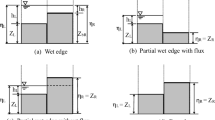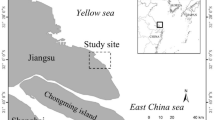Abstract
Hydrologic processes in tidal wetlands are important regulators controlling the growth and productivity of salt marsh plants. Understanding hydrodynamic and hydrological processes is therefore critical to sustaining ecosystem functions and productivity in tidal wetlands. We used remote sensing and geographic information system to determine the spatial distributions of Suaeda heteroptera and Phragmites australis plants on the tidal-flats of Liao River Estuary (LRE), China. Next, hydrodynamic modelling was performed to characterize the water levels and tidal currents in these wetland waters. After extensive calibration and validation against field data, we proposed a 2D circulation structure for the LRE that can be used to calculate the hydrological parameters in different areas of the tidal wetlands. The simulation results showed that the hydrological characteristics of the tidal wetlands were primarily dependent on local topography and water level. The prevalent plant community in the LRE, dominated by Suaeda heteroptera, was abundant across a large range of flood times (0.79 ~ 3.22 h/day), inundation frequencies (11 ~ 52 times/month), and max flooding depths (0.42 ~ 0.81 m). However, certain hydrological conditions did appear to limit the spatial distributions of wetland plant communities. These findings have provided detailed methods of a novel approach to quantitatively assess habitat status in tidal-flat wetlands.










Similar content being viewed by others
Data availability
The research data are provided in the Supplement.
Code Availability
MIKE 21 HD module.
References
Allinson G (2017) Effect of increasing salinity on development of Giant reed (Arundo donax) from rhizome and culms. Bulletin of Environmental Contamination and Toxicology 99:743–747
Alongi DM (2008) Mangrove forests: resilience, protection from tsunamis, and responses to global climate change. Estuarine, Coastal and Shelf Science 76(1):1–13
Barros MLC, daSilva TD, da Cruz AGB et al (2020) Numerical simulation of wetland hydrodynamics andwater quality. Journal of the Brazilian Society of Mechanical Sciences and Engineering 42(444):1–15
Benz UC, Hofmann P, Willhauck G et al (2004) Multi-resolution, object-oriented fuzzy analysis of remote sensing data for GIS-ready information. ISPRS Journal of Photogrammetry and Remote Sensing 58(3–4):239–258
Berlanga-Robles CA, Ruiz-Luna A, Bocco G et al (2011) Spatial analysis of the impact of shrimp culture on the coastal wetlands on the northern coast of Sinaloa, Mexico. Ocean and Coastal Management 54(7):535–543
Bullock A, Acreman M (2003) The role of wetlands in the hydrological cycle. Hydrology and Earth System Sciences 7:358–389
Casanova MT, Brock MA (2000) How do depth, duration and frequency of flooding influence the establishment of wetland plant communities? Plant Ecology 147(2):237–250
Chen YY, Vigouroux G, Bring A et al (2019) Dominant hydro-climatic drivers of water temperature, salinity, and flow variability for the large-scale system of the Baltic coastal wetlands. Water 11:552
Cox BA (2003) A review of currently available in-stream water-quality models and their applicability for simulating dissolved oxygen in lowland rivers. Science of the Total Environment 314-316:335–377
Donnelly JP, Bertness MD (2001) Rapid shoreward encroachment of salt marsh cordgrass in response to accelerated sea-level rise. Proceedings of the National Academy of Sciences 98(25):14218–14223
Erwin KL (2009) Wetlands and global climate change: the role of wetland restoration in a changing world. Wetlands Ecology and Management 17:71–84
Fan YB, Zhou DM, Ke YH et al (2020) Quantifying the correlated spatial distributions between tidal creeks and coastal wetland vegetation in the Yellow River estuary. Wetlands 40:2701–2711
Gedan KB, Kirwan ML, Wolanski E et al (2011) The present and future role of coastal wetland vegetation inprotecting shorelines: answering recent challenges to the paradigm. Climatic Change 106:7–29
Hammersmark CT, Dobrowski S, Rains MC et al (2010) Simulated effects of stream restoration on herbaceous vegetation distribution. Restoration Ecology 18:882–893
Keim R, Zoller JA, Braud DWH et al (2013) Classification of forested wetland degradation using ordination of multitemporal reflectance. Wetlands 33(6):1103–1115
Langevin CD, Swain ED, Wolfert MA (2005) Simulation of integrated surface-water/ground-water flow and salinity for a coastal wetland and adjacent estuary. Journal of Hydrology 314:212–234
Li X, Bellerby R, Craft C et al (2018) Coastal wetland loss, consequences, and challenges for restoration. Anthropocene Coasts 1:1–15
Liu J, Engel BA, Dai L et al (2019) Capturing hydrological connectivity structure of wetlands with indices based on graph theory: a case study in Yellow River Delta. Journal of Cleaner Production 239:1–9
McClain ME, Boyer EW, Dent CL et al (2003) Biogeochemical hot spots and hot moments at the interface of terrestrial and aquatic ecosystems. Ecosystems 6(4):301–312
McKee K, Mendelssohn IA, Materne MD (2004) Acute salt marsh dieback in the Mississippi River deltaic plain: a drought - induced phenomenon? Global Ecology and Biogeography 13(1):65–73
Mitsch WJ, Gosselink JG (2000) Wetlands, 3rd edn. John Wiley & Sons, Inc., NewYork
Qiao HT, Zhang ML, Jiang HZ et al (2018) Numerical study of hydrodynamic and salinity transport processes in the Pink Beach wetlands of the Liao River estuary, China. Ocean Science 14:437–451
Sánchez E, Scordia D, Lino G et al (2015) Salinity and water stress effects on biomass production in different Arundo donaxL. Clones Bioenergy Research 8:1461–1479
Sivaperuman C, Venkatraman C (2015) Coastal and marine bird communities of India. Marine Faunal Diversity in India, 261–281
Somes NLG, Bishop WA, Wong THF (1999) Numerical simulation of wetland hydrodynamics. Environment International 25(6–7):773–779
Stark J, Plancke Y, Ides S et al (2016) Coastal flood protection by a combined nature-based and engineering approach: modeling the effects of marsh geometry and surrounding dikes. Estuarine, Coastal and Shelf Science 175(20):34–45
Sun ZG, Mou XJ, Sun WL (2016) Potential effects of tidal flat variations on decomposition and nutrient dynamics of Phragmites australis, Suaeda salsa, and Suaeda glauca litter in newly created marshes of the Yellow River estuary, China. Ecological Engineering 93:175–186
Temmerman S, Bouma TJ, Govers G et al (2005) Impact of vegetation on flow routing and sedimentation patterns: three-dimensional modeling for a tidal marsh. Journal of Geophysical Research 110:F04019. https://doi.org/10.1029/2005JF000301
Todd MJ, Muneepeerakul R, Pumo D et al (2010) Hydrological drivers of wetland vegetation community distribution within Everglades National Park. Florida. Advances in Water Resources 33(10):1279–1289
Twilley RR, Chen R (1998) A water budget and hydrology model of a forest in Rookery Bay. Florida. Marine Freshwater Research 49(4):309–323
Vivian LM, Marshall DJ, Godfree RC (2014) Response of an invasive native wetland plant to environmental flows: implications for managing regulated floodplain ecosystems. Journal of Environmental Management 132:268–277
Wang Y, Liu RH, Gao HW et al (2010) Degeneration mechanism research of Suaeda heteroptera wetland of the Shuangtaizi estuary National Nature Reserve in China. Procedia Environmental Sciences 2:1157–1162
Wester SJ, Grimson R, Minotti PG et al (2018) Hydrodynamic modelling of a tidal delta wetland using an enhanced quasi-2D model. Journal of Hydrology 559:315–326
Xu XL, Zhang Q, Tan ZQ et al (2015) Effects of water-table depth and soil moisture on plant biomass, diversity, and distribution at a seasonally flooded wetland of Poyang Lake, China. Chinese Geographical Science 25:739–756
Zhang Y, Li WH, Sun G et al (2018) Understanding coastal wetland hydrology with a new regional-scale, process-based hydrological model. Hydrological Processes 32(20):3158–3173
Zhao LZ, Chen CS, Vallino J et al (2010) Wetland–estuarine - shelf interactions in the Plum Island sound and Merrimack River in the Massachusetts coast. Journal of Geophysical Research 115:C10039. https://doi.org/10.1029/2009JC006085
Funding
This work was supported by the National Key R&D Program of China (2019YFC1407704), the National Nature Science Foundation of China (51879028), the Open Fund of State Key Laboratory of Coastal and Offshore Engineering, Dalian University of Technology (LP2009), and Dalian Science and Technology Innovation Fund Project (Grant No. 2021JJ11CG001).
Author information
Authors and Affiliations
Contributions
YN performed the experiment and the data analyses, ML contributed to the conception of the study and wrote the manuscript.
Corresponding author
Ethics declarations
Competing Interests
No other author has reported a potential conflict of interest relevant to this article.
Ethics Approval
Not applicable.
Consent to Participate
Not applicable.
Consent for Publication
Not applicable.
Additional information
Publisher’s Note
Springer Nature remains neutral with regard to jurisdictional claims in published maps and institutional affiliations.
Highlights
• The hydrodynamic model was used to simulate the wetting and drying cycles in tidal wetlands of the LRE.
• RS and GIS technology were used to measure the spatial distributions of salt-marsh plants in tidal wetlands.
• New insights into the analysis of suitable hydro-period conditions in tidal wetlands are presented.
Rights and permissions
About this article
Cite this article
Wang, Y., Zhang, M. Modeling Hydrodynamic and Hydrological Processes in Tidal Wetlands. Wetlands 42, 1 (2022). https://doi.org/10.1007/s13157-021-01519-1
Received:
Accepted:
Published:
DOI: https://doi.org/10.1007/s13157-021-01519-1




